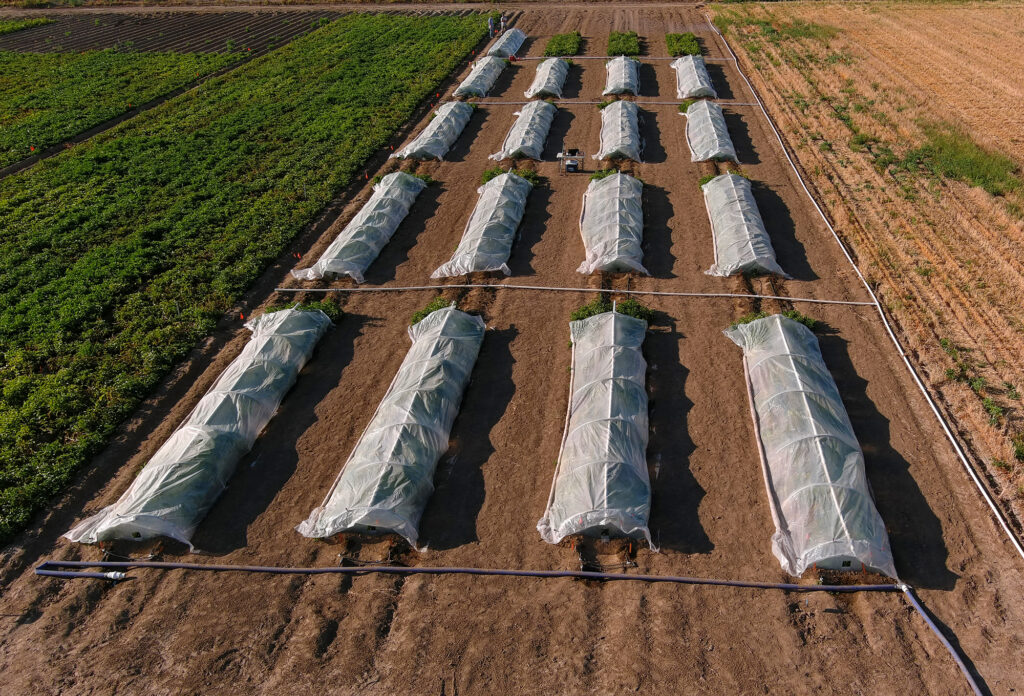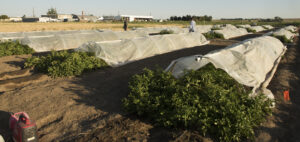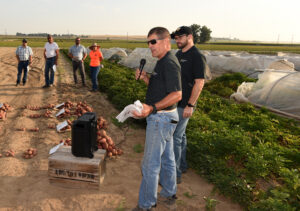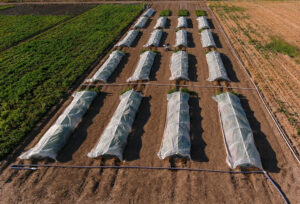
Project aims to smoke out answers
Nearly 12 years ago, while inspecting a Washington potato field in 2012, Addie Waxman first observed the impact of wildfire smoke on potato plants.
“I was evaluating fields with my co- workers with a grower,” Waxman said. “I looked out and said, ‘Why is this field down? What has happened? It’s not nearly time for vine kill and harvest,’ and he (the farmer) said, ‘Oh, that variety can’t handle the smoke, it happens almost every time.’ That’s when I got really interested in the impact of smoke.”
Fast forward a decade to 2022. Waxman is McCain Foods USA’s North America manager of agronomy for potato storage, and smoke from wildfires across the Pacific Northwest has become an even greater problem for potato processors.
In an effort to determine wildfire smoke’s impact on tuber development within the process potato industry, Waxman secured a two-year USDA Specialty Crop Block Grant for $125,000 administered by the Idaho State Department of Agriculture.

Working with researchers from Boise State University (BSU) and the University of Idaho’s (U of I) College of Agricultural and Life Sciences, Waxman put together a team of researchers to explore the agronomic, culinary and economic impacts that wildfire smoke potentially has on potatoes grown for the french fry market.
“I reached out to people I thought were the best, and that was Mike Thornton, Owen McDougal (and) Josh Bevan,” Waxman said. “I added Joe Guenthner (for economic analysis) because money talks. You can have a nice project, but if it doesn’t show an effect on the bottom line, there’s little interest.”
Thornton is a professor of plant sciences at U of I’s Parma Research and Extension Center. McDougal is the chairman of the Chemistry Department and director of Food and Dairy Innovation Center for BSU. Bevan is the director of the U of I Food Technology Center in Caldwell, and Guenthner is an emeritus professor of agricultural economics at U of I.
POTATO PREPARATION
During the 2022 and 2023 growing season, Thornton, assisted by Ajay Atkinson (Atkinson also works with Owen McDougal during the fall and spring semesters), an undergraduate assistant for BSU, and the Parma staff, grew three varieties of potatoes for the study: Alturas, Clearwater Russet and Russet Burbank, varieties commonly processed to make french fries.
“We went from the middle of July to the middle of August, six weeks, five days a week, smoked them really heavy every morning,” Thornton said of the process. “We (were) trying to replicate what history told us would be the highest risk time, and that matches with when the tubers are bulking, when the plants are putting on most of their yield. So you think that if the smoke is going to cause an impact, it should be at that time of year.”
Thornton said that over the two-year average, researchers saw U.S. No. 1 yield drop by 3% compared to the control group, with a 2% drop in tubers over 6 ounces in size and an increase in culls of 2%.

“We had fewer large size potatoes and more culls, so it does seem like just the chemicals in smoke — if you take out what it’s doing to light intensity, what it’s doing to temperature, humidity — the chemical constituents in smoke itself seem to be affecting the growth of the potato plant,” Thornton said.
The one consistency through both years of trials was the lack of an impact on total yield.
“We didn’t see an impact on total yield, both years,” Thornton said. “It ended up on average across the two years being almost identical total yields when you put all the data together.”
Smoke’s impact on potatoes, Thornton said, is not dramatic and is comparatively similar to other forms of stress such as heat or lack of water.
“My conjecture would be that if you have those (heat and/or water stress) and you have the smoke come in, that’s going to hurt those fields more than fields that aren’t under stress,” he said. “It compounds any stress that’s already going on.”
POSTHARVEST ANALYSIS
Following harvest, the potatoes were sent to McDougal at BSU.
“One of the things we want to look at is, does the influence of smoke exposure affect the raw material for acrylamide formation, and do we get higher acrylamide product from potatoes that have been smoke- exposed?” McDougal said.
He said between 3,000 and 6,000 metabolites are found in each potato variety.

McDougal, assisted by Atkinson, conducted a metabolic analysis of half the potatoes immediately after harvest. Bevan then processed the first half of potatoes into french fries by either par frying or fully frying them.
McDougal and his team further studied the fries for the total amount of reducing sugars, asparagine and acrylamide. The other half of potatoes went into storage for six months before another round of metabolic analysis to determine any changes during storage. They were then sent to Bevan for fry processing and put through another round of metabolic analysis.
Discussing the second-year results in December 2023, Atkinson said that the overall smoke effect created a slight drop in reducing sugars on all three varieties, while asparagine levels dropped in Alturas and Russet Burbanks but increased in Russet Clearwater.
McDougal and Atkinson both noted that the smoked potatoes made darker fries even though the reducing sugars in the potatoes was lower.
Sugars and asparagine are precursors to acrylamide formation, McDougal said. “So, ideally, if those levels are higher within a potato variety, you would expect more acrylamide during the frying process under the same conditions,” he said. “That’s what we’d expect, but I’m not sure that’s what we saw.”
One finding stood out to McDougal: Potatoes stored for six months were found to have lower reducing sugars but produced darker fries.
“Reducing sugars are part of the color component; you would almost expect a lighter fry,” he said. “So there were some disparities in what you would expect based on the chemical composition.”
The research will be completed with Guenthner’s economic cost analysis, expected later this year.














